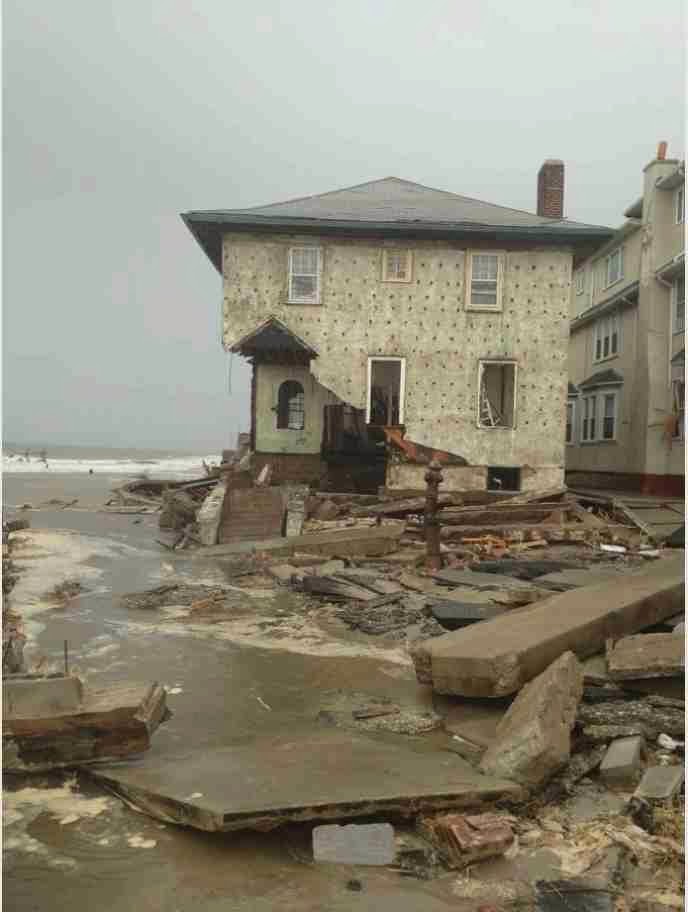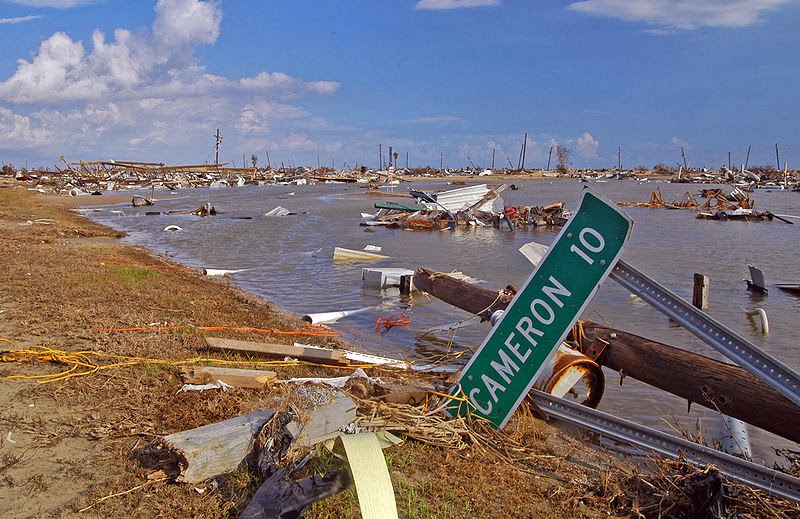Let's find another beauty with another species of Philodendron, Philodendron florida beauty variegated.
Memory Record of Storm Damage
Storms generally lead to negative impacts to lives and property such as storm surge, heavy rain or snow (causing flooding or road impassibility), lightning, wildfires, and vertical wind shear; however, systems with significant rainfall can alleviate drought in places they move through. Heavy snowfall can allow special recreational activities to take place which would not be possible otherwise, such as skiing and snowmobiling.
Data refer: http://en.wikipedia.org
http://commons.wikimedia.org
Hurricane Katrina aftermath in New Orleans
New Orleans, La. August 2005 -- Aerial of a flooded roadway coming out of the flood waters and then going back in. Oil slicks are visible on the surface of the water. New Orleans is being evacuated as a result of floods. Thousand of people have been rescued from the flood waters by moving to their roofs and attics. Photo by Jocelyn Augustino/FEMA
Hurricane-caused shipwrecks
Southern Louisiana, September 12, 2005 -- Boats tossed around by Hurricane Katrina remain lodged on dry ground. By the Empire High Bridge, Plaquemines Parish. Jocelyn Augustino/FEMA
Galeston Texas after Hurricane Ike: Trolley Stop at Pier 21, with grounded boat
The aftermath of Hurricane Camille. 17 August 1969
Damaged boats and docks in Grand Isle Louisiana after Hurricane Katrina.
Between 31 August and 19 September, 2005
Emma 2008 (storm)
2010 Victorian storms
Hurricane Sandy
Hurricane Sandy (unofficially known as "Superstorm Sandy") was the deadliest and most destructive hurricane of the 2012 Atlantic hurricane season, as well as the second-costliest hurricane in United States history. Classified as the eighteenth named storm, tenth hurricane and second major hurricane of the year, Sandy was a Category 3 storm at its peak intensity when it made landfall in Cuba.While it was a Category 2 storm off the coast of the Northeastern United States, the storm became the largest Atlantic hurricane on record (as measured by diameter, with winds spanning 1,100 miles (1,800 km)).[2][3] Estimates as of June 2013 assess damage to have been over $68 billion (2013 USD), a total surpassed only by Hurricane Katrina. At least 286 people were killed along the path of the storm in seven countries.
Hurricane Rita
Hurricane Rita was the fourth–most intense Atlantic hurricane ever recorded and the most intense tropical cyclone ever observed in the Gulf of Mexico. Part of the record-breaking 2005 Atlantic hurricane season, which included three of the six most intense Atlantic hurricanes ever (along with #1 Wilma and #6 Katrina), Rita was the eighteenth named storm, tenth hurricane, and fifth major hurricane of the 2005 season. Rita formed near The Bahamas from a tropical wave on September 18 that originally developed off the coast of West Africa. It moved westward, and after passing through the Florida Straits, Rita entered an environment of abnormally warm waters. It rapidly intensified to reach peak winds of 180 mph (285 km/h) on September 20. After steadily weakening and beginning to curve to the northwest, Rita gradually weakened and made landfall on Sabine Pass, Texas with winds of 120 mph (195 km/h) on September 24. It weakened over land and degenerated into a large low-pressure area over the lower Mississippi Valley on September 26.
Cyclone Nargis
Cyclone Nargis (JTWC designation: 01B, also known as Very Severe Cyclonic Storm Nargis) was a rare, eastward moving at low-latitude strong tropical cyclone that caused the worst natural disaster in the recorded history of Myanmar.The cyclone made landfall in Myanmar on Friday, 2 May 2008, sending a storm surge 40 kilometers up the densely populated Irrawaddy delta, causing catastrophic destruction and at least 138,000 fatalities.The Labutta Township alone was reported to have 80,000 dead, with about 10,000 more deaths in Bogale. There were around 55,000 people missing and many other deaths were found in other towns and areas, although the Myanmar government's official death toll may have been underreported, and there have been allegations that government officials stopped updating the death toll after 138,000 to minimize political fallout. The feared 'second wave' of fatalities from disease and lack of relief efforts never materialized.Damage was estimated at over K62,988,000,000 (US$10 billion), which made it the most damaging cyclone ever recorded in this basin.
Memory Record of Fruit dove
These small- to medium-sized doves generally have short, fan-shaped tails,and are remarkable for their colourful and often glossy plumage, as evidenced in the aptly named Orange Fruit Dove, Flame-breasted Fruit Dove, and Pink-headed Fruit Dove.Males and females of many fruit dove species look very different. For example, the female Many-coloured Fruit Dove shares the male’s crimson crown and deep pink undertail feathers, but is otherwise green, whereas the male has a crimson on the upper back and has areas of yellow, olive, cinnamon, and grey.
The many species of this genus can be further grouped by geography and by certain shared characteristics. The fruit doves of the Sunda Islands and northern Australia, such as the Pink-headed Fruit Dove and Banded Fruit Dove, have comparatively longer tails than other species, and are notable for their solid colouration on the head, neck and breast, with a black band across the belly. Another grouping can be made of certain fruit doves endemic to New Guinea, the Moluccas, and the Bismarck Archipelago, including the Carunculated Fruit Dove, Knob-billed Fruit Dove, and others; these are notable for their grey colouration on the head or shoulder and/or enlarged cere (part of the bill). This group is uncharacteristically not sexually dimorphic, meaning males and females look alike. The Orange Dove, Golden Dove, and Whistling Dove, all endemic to Fiji and sometimes placed in their own genus Chrysoenas, have in common their small size, compact shape, yellow or orange colouration in the males, and hair-like body feathers. They also are known for their rather un-pigeon-like vocalizations, which sound like snapping, barking, or whistling, respectively.[1] Finally, the Pacific Islands provide homes to a number of species that share generally green colouration with crimson caps or crowns, ventriloquial cooing or hooting, and a distinct texture of the breast feathers.[2] The Grey-green Fruit Dove is typical of this group.[1] Recent evidence suggests Ptilinopus as presently defined is paraphyletic as Alectroenas and Drepanoptila are embedded within it.[4] The generic name Ptilinopus comes from the Ancient Greek words ptilon "feather," and pous, "foot.
Data refer : http://en.wikipedia.org/wiki/Fruit_dove
Beautiful Fruit Dove
Jambu Fruit Dove
Mariana Fruit Dove
Orange Fruit Dove
Ornate Fruit Dove
Pink-headed Fruit Dove
Wompoo Fruit Dove
Yellow-breasted Fruit Dove
Memory Record of Castle
 |
| Bamburgh Castle, Northumberland |
Many castles were originally built from earth and timber, but had their defences replaced later by stone. Early castles often exploited natural defences, and lacked features such as towers and arrowslits and relied on a central keep. In the late 12th and early 13th centuries, a scientific approach to castle defence emerged. This led to the proliferation of towers, with an emphasis on flanking fire. Many new castles were polygonal or relied on concentric defence – several stages of defence within each other that could all function at the same time to maximise the castle's firepower. These changes in defence have been attributed to a mixture of castle technology from the Crusades, such as concentric fortification, and inspiration from earlier defences such as Roman forts. Not all the elements of castle architecture were military in nature, and devices such as moats evolved from their original purpose of defence into symbols of power. Some grand castles had long winding approaches intended to impress and dominate their landscape.
Although gunpowder was introduced to Europe in the 14th century, it did not significantly affect castle building until the 15th century, when artillery became powerful enough to break through stone walls. While castles continued to be built well into the 16th century, new techniques to deal with improved cannon fire made them uncomfortable and undesirable places to live. As a result, true castles went into decline and were replaced by artillery forts with no role in civil administration, and country houses that were indefensible. From the 18th century onwards, there was a renewed interest in castles with the construction of mock castles, part of a romantic revival of Gothic architecture, but they had no military purpose.
Data refer :http://commons.wikimedia.org
Data refer :http://en.wikipedia.org/wiki/Castle
 |
| The Tower of London |
 |
| Arundel Castle, West Sussex |
 |
| Windsor Castle |
 |
| Chateau de Pesteil |
 |
| Chateau de Trécesson |
 |
| Fort La Latte en Bretagne |
 |
| Chateau de Sully sur Loire |
 |
| Schweriner Schloss |
 |
| Schloss Neuschwanstein |
 |
| Marksburg |
 |
| Castle of Fénis |
 |
| Castle of Manzanares el Real, Madrid |
 |
| Maschio Angioino in Napoli |
 |
| Kilkenny Castle |
 |
| Ordensburg mit Kirche in Poland |
 |
| Gniew |
 |
| Maruoka Castle in Japan |
 |
| Matsumoto Castle in Japan |
 |
| Himeji Castle in Japan |
 |
| Visegrád castle |
Subscribe to:
Posts (Atom)













































